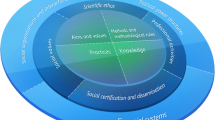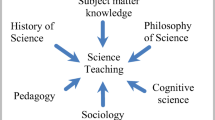Abstract
This study considers the relationship between science, science teaching and the philosophy of science perceiving these three cultural phenomena as a semantic triad. This approach presents science teaching as being a form of a scientific reflection. The relationship of science teaching to the philosophy of science is advocated to be essential, revealing the conceptual meaning of science in the science curriculum and thus removing the semantic degeneracy taking place when the philosophy of science is ignored in science education. The study points at the bricolage as well as magic nature of the science curriculum preserving as long as science teaching preserves semantic degeneracy. Different types of meaning of Schwab’s commonplaces were recognized. The study challenges the common view of the relationship between science, science teaching and pedagogy and suggests effective representation of individual knowledge of science educators.
Similar content being viewed by others
References
InstitutionalAuthorNameAAAS, American Association for the Advancement of Science (1990) Science for All Americans Oxford University Press NY
R. Amir P. Tamir (1994) ArticleTitle‘In-Depth Analysis of Misconceptions as a Basis for Developing Research-Based Remedial Instruction: The Case of Photosynthesis’ American Biology Teacher 56 IssueID2 94–100
R.D. Anderson A. DeVito O.E. Dyrli M. Kellogg L. Kochendorfer J. Weigand (1970) Developing Children’s Thinking Through Science Prentice Hall Englewood Cliffs, NJ
Th. Aquinas (1273/1952) Summa Theologica Encyclopaedia Britannica Chicago
A.B. Arons (1997) Teaching Introductory Physics Wiley NY
M.M. Bakhtin (1986) Speech Genres and Other Late Essays University of Texas Press Austin, TX
R. Barthes (1957) Mythologies Seuil Paris
Barthes, R.: 1968/1984, ‘From Science to Literature’, in Le Bruisseinent de la Langue, Essais Critiques IV. De La Science a la Litterature, Seuil, Paris.
R. Barthes (1977) Image-Music-Text Fontana London
M. Born (1953) ArticleTitle‘The State of Ideas in Physics and the Perspectives of Their Further Development’ Proceedings of the Physical Society 66 501
J.S. Bruner (1960) The Process of Education Vintage NY
E. Cassirer (1965) The Philosophy of Symbolic Forms Yale University Press New Haven & London
R. Chabay B. Sherwood (1995) Electric and Magnetic Interactions Wiley New York
R.G. Collingwood (1939/1978) An Autobiography Oxford University Press Oxford 31
G.E. DeBoer (1991) A History of Ideas in Science Education Columbia University New York 173–190
B.S. Eylon U. Ganiel (1990) ArticleTitle‘Macro-Micro Relationships: the Missing Link Between Electrostatics and Electrodynamics in Students Reasoning’ International Journal of Science Education 12 IssueID1 79–94
P.J. Fensham (1986) ArticleTitle‘Science for All’ Educational Leadership 44 18–23
G. Frege (1892/1966) ‘On Concept and Object’ P. Geach M. Black (Eds) Translations from Philosophical Writings of Gottlob Frege Oxford University Press Oxford 42
G. Frege (1892/1994) ‘On Sense and Reference’ F. Zabeeh A. Jacobson E. D. Klenake (Eds) Readings in Semantics University of Illinois Press Urbana 118–140
H.G. Gadamer (1975) Truth and Method The Seabury Press New York
G. Galilei (1632/1962) Dialogue Concerning the Two Principle Systems of the World University of California Press Berkeley, CA
G. Galilei (1638/1954) Dialogues Concerning the Two New Sciences Dover New York
I. Galili E.I. Goihbarg (2005) ArticleTitle‘Energy Transfer in Electrical Circuit – a Qualitative Account’ American Journal of Physics 73 IssueID2 141–144 Occurrence Handle10.1119/1.1819932
I. Galili D. Kaplan (1997) ArticleTitle‘Changing Approach in Teaching Electromagnetism in a Conceptually Oriented Introductory Physics Course’ American Journal of Physics 65 IssueID7 657–668 Occurrence Handle10.1119/1.18623
I. Galili D. Sela (2004) ArticleTitle‘Pendulum Activities in the Israeli Physics Curriculum: Used and Missed Opportunities’ Science & Education 13 IssueID4–5 459–472
I. Galili M. Tseitlin (2003) ArticleTitle‘Newton’s First Law: Text, Translations, Interpretations, and Physics Education’ Science & Education 12 IssueID1 45–73
I. Galili (2001) ArticleTitle‘Weight Versus Gravitational Force: Historical and Educational Perspectives’ International Journal of Science Education 23 IssueID10 1073–1093 Occurrence Handle10.1080/09500690110038585
I. Halloun D. Hestenes (1985) ArticleTitle‘The Initial Knowledge State of College Students’ American Journal of Physics 53 1043–1055
I. Halloun D. Hestenes (1998) ArticleTitle‘Interpreting VASS Dimensions and Profiles’ Science & Education 7 IssueID6 553–577 Occurrence Handle10.1023/A:1008645410992
J. Handelsman D. Ebert-May R. Beichner P. Bruns A. Chang R. DeHaan J. Gentile S. Lauffer J. Stewart S.M. Tilghman W.B. Wood (2004) ArticleTitle‘Scientific Teaching’ Science 304 521–522 Occurrence Handle10.1126/science.1096022
W. Heisenberg (1958) Physics and Philosophy Harper New York
M. Jammer (1957) Concepts of Force Harper New York
H. Kearney (1971) Science and Change 1500–1700 McGraw Hill New York
C. Levi-Strauss (1968) The Savage Mind University of Chicago Press Chicago
M. Matthews (1994) Science Teaching, The role of the History and Philosophy of Science Routledge New York
M. Matthews (2000) Time for Science Teaching Kluwer Academic New York
M. Matthews (2004) ArticleTitle‘Reappraising Positivism and Education: The Arguments of Philip Frank and Herbert Feigl’ Science & Education 13 IssueID1–2 7–39
W.F. McComas (1998) ‘The Principal Elements of the Nature of Science: Dispelling the Myths’ W.F. McComas (Eds) The Nature of Science in Science Education Kluwer Dordreht, The Netherlands 53–70
W. North (1995) Handbook of Semiotics Indiana University Press Bloomington, IN
Peirce, C.S.: Collected Papers of Charles Sanders Peirce, 1931–1958, Vols. 1–6 ed. C. Hartshorne & P. Weiss (eds.), Cambridge, MA, Harvard University Press.
J. Piaget (1970) Structuralism Basic Books New York
Pietschmann, H.: 2001, ‘How to Teach Physics in an Anti-Scientific Society’, The Pantaneto Forum (4), http://www.pantaneto.co.uk/issue4.
Plato: 1952, Dialouges, Encyclopaedia Britannica, Chicago.
J. Redish (2003) Teaching Physics with Physics Suite Wiley New York 11
Reichenbach, H.: 1928/1958, The Philosophy of Space and Time, Dover, New York.
J. Rutherford G. Holton F. Watson (1970) The Project Physics Course Holt, Rinehart Winston, New York
J.J. Schwab (1964a) ‘Problems, Topics, and Issues’ S. Elam (Eds) Education and the Structure of Knowledge Rand McNally Chicago 4–47
J.J. Schwab (1964b) Biology Teacher’s Handbook Wiley New York
J.J. Schwab (1966) Teaching of Science Harvard University Press Cambridge, MA
J.J. Schwab (1978) ‘Education and the Structure of the Disciplines’ I. Westbury N.J. Wilkof (Eds) Science, Curriculum, and Liberal Education Rand McNally Chicago
L. Shulman (1986) ArticleTitle‘Those Who Understand: Knowledge Growth in Teaching’ Educational Researcher 15 IssueID2 4–14
L. Shulman (1987) ArticleTitle‘Knowledge and Teaching: Foundations of the New Reform’ Harvard Educational Review 57 1–22
Stepanov, J.S.: 1971, Semiotika, Nauka, Moskva (in Russian).
D.O. Tall S. Vinner (1981) ArticleTitle‘Concept Image and Concept Definition in Mathematics, with Special Reference to Limits and Continuity’ Educational Studies in Mathematics 12 151–169 Occurrence Handle10.1007/BF00305619
Tseitlin, M. & Galili, I.: 2005, ‘Teaching Physics in Looking for Itself: From a Physics-Discipline to A Physics Culture’, Science & Education, to be published.
S. Weinberg (2001) Facing Up Harvard University Press Cambridge, MA
R. Yager (1985) ArticleTitle‘In Defense of Defining Science Education as the Science/Society Interface’ Science Education 69 143–144
Author information
Authors and Affiliations
Corresponding author
Rights and permissions
About this article
Cite this article
Tseitlin, M., Galili, I. Science Teaching: What Does It Mean?. Sci Educ 15, 393–417 (2006). https://doi.org/10.1007/s11191-005-8261-x
Issue Date:
DOI: https://doi.org/10.1007/s11191-005-8261-x




